
Equipment
Apart from Hives of bees, the well dressed beekeeper needs several pieces of equipment for successful beekeeping.... As the picture below illustrates.
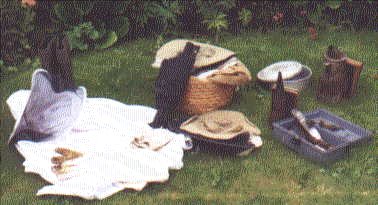
Our Equipmet

First we have a tool box....
What is in the box....

Tools are in the box..... "hive tools"...
A mixture of scrapers, wire brushes and hive tools are there to prise open the boxes and gummed-up frames. (The bees gum up all gaps in sight with resin... (Propolis)....

The Most important tool is the hive tool itelf. It has a sharpened end for prising open the boxes and a curved end to lift out the frames
.
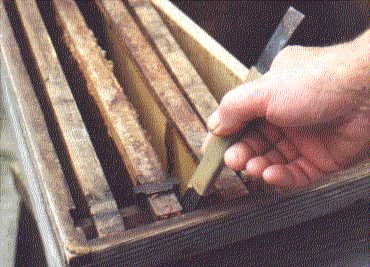
A hive tool in action!
Other tools in the box include, matchboxes, queen marking cages, bee escapes, secateurs, a record book (vital piece of equipment). Indeed we need to pack anything we can think of into the box as once in a hive of angry bees there is no going back for anything forgotten.....
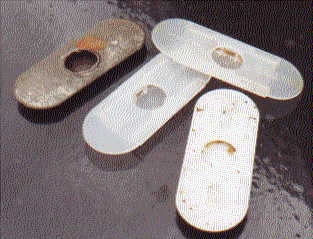 Here
we see some "porter escapes". they are placed in cutouts on
the hive roof boards They are useful addtions to the tool box as when
placed on a hive they only allow bees one way (down through the hole)
so can be used to empty them frome hive boxes.
Here
we see some "porter escapes". they are placed in cutouts on
the hive roof boards They are useful addtions to the tool box as when
placed on a hive they only allow bees one way (down through the hole)
so can be used to empty them frome hive boxes.
 Here
is a queen capture cage in its tin box. The queen can be caged in. It
is often used for marking her
Here
is a queen capture cage in its tin box. The queen can be caged in. It
is often used for marking her
It is not just a box of tools that we need to take with us..... We need "smokers"

Smokers are used to "calm the bees". Don't ask me how it works but it does. One theory is that the smoke simulates a forest fire. The bees panic and start eating the honey in preparation for evacuating the hive and thus they are less likely to sting when disturbed. Anyway, it seems to work and calms the bees down. Don't overdo it though, imagine all those poor bees coughing with smoke in their eyes! How does ht work?A "smoker" is basically a canister with a funnel-tube on the top and bellows to puff smoke at the bees in the hive, the canister is filled with dry material such as cardboard, dry grass etc. to "fuel" it.

Cover cloths:
These black cloths are used to cover an open hive to keep the bees calm
as we are working on it. They can be gradually rolled back allowing us
to expose only a few frames at a time thus keeping the bees calm and as
undisturbed as possible.
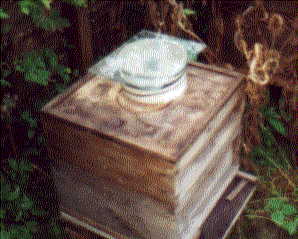
Feeders.
. These are containers like biscuit tins with a tube up the middle which
are used (usually one per hive) to "feed" a colony of bees with
sugar solution. The feeder is placed over an opening at the top of a hive
so that the hungry bees can climb up through the tube into the container
to feed on the sugar.
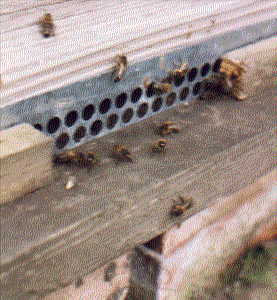
Mouseguards:
These are metal strips with holes in them which are placed at the entrance
to a hive in Winter to deter hungry, inquisitive rodents from attacking
the colony, eating the honey and destroying the honeycomb. The holes in
the strips are only large enough for the bees to pass through but too
small for other animals.
And finally, what about us! A pair of strong, thick leather gauntlets
protect us against stings
and our bodies are also totally covered - there must be NO gaps! Angry bees can sneek through the tiniest hole, and sting! Our heads and faces are protected by a hat with a mesh veil which allows us to see but not stung!
This does not always work however!
Kitted-up and ready for action!

